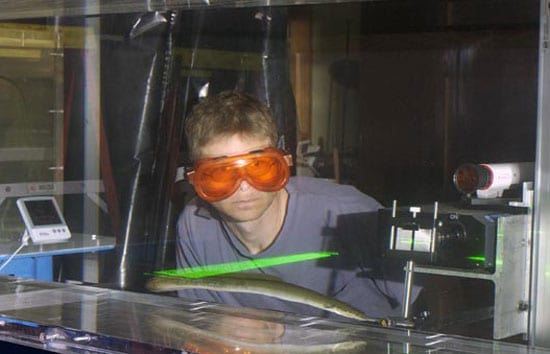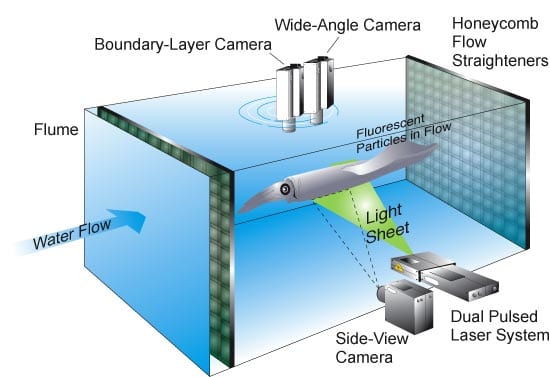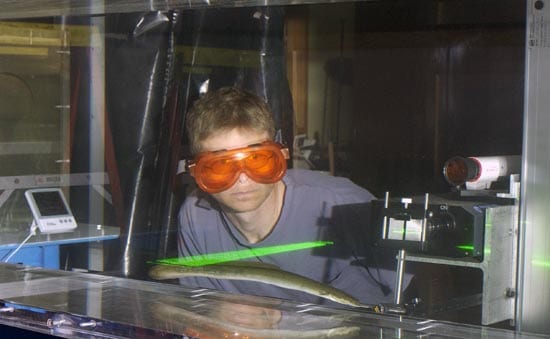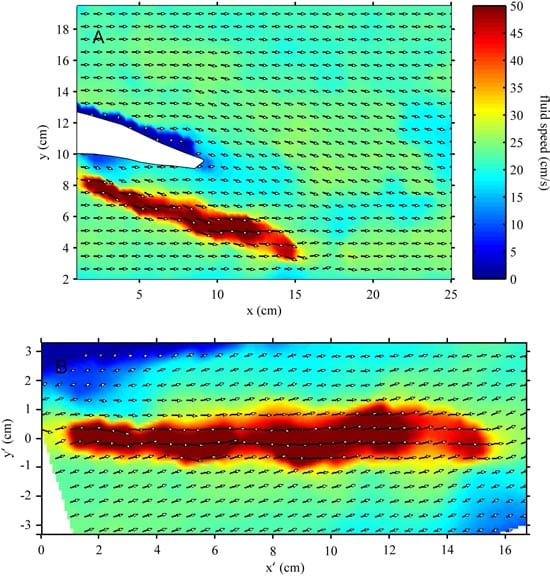
Scientists Find a New Twist in How Squids Swim
In real life, squids behave differently than they do in theory
Erik Anderson was vexed by scientific papers he read during his first year of graduate studies in the MIT/WHOI Joint Program. Two groups of engineers asserted that squids likely propelled themselves through water by creating vortex rings—that is, by forcing fluid out of their pipe-shaped funnels so that the jets roll up into smoke-ring-like structures.
Anderson, who had studied squids while working on a master’s degree, begged to differ. Together with his Ph.D. thesis advisor, Mark Grosenbaugh of the WHOI Department of Applied Ocean Physics and Engineering, Anderson set up a series of experiments to check the theories against some observational evidence.
Laboratory experiments, using cylindrical pipes in still water, showed that vortex rings provide efficient propulsion, so engineers presumed squid took advantage of them. “They suggested this without looking closely at a squid swimming,” said Anderson. “This failure to consider the real biological system led them to wrong conclusions. We knew something else was going on.”
Anderson and Grosenbaugh put live squid into a flume theybuilt in WHOI’s Rinehart Coastal Research Laboratory. They added microscopic, silver-coated beads to the water, shined laser light on the squid and beads, and imaged the motion of their experimental ocean. The technique allowed them to visualize and measure the jet emitted from the squid and the water streamingby.
Analyzing the flow, Anderson saw that squid propel themselves with prolonged column-shaped jets, like the full-blast flow from a garden hose. “The squid expel fluid for relatively long periods of time,” he noted, “and they don’t ‘puff’ in the way that would be necessary to produce vortex rings.”
“Rings emitted from a stationary structure—such as a smokestack or a squid starting from rest in still water—are a very efficient means for moving fluid,” said Anderson, now a postdoctoral fellow at HarvardUniversity and a visiting scientist at WHOI. But when a squid is jetting through moving water, the flow from the squid’s funnel (which sits above the eyes and beneath the mantle sheath) meets the current flowing over the animal. This current prevents the jet from rolling up into a vortex ring.
The work by Anderson and Grosenbaugh was featured earliert his year in the Journal of Experimental Biology. It served as a reminder of the importance of real-life experiments in the fast-growing field of biomechanics.
For instance, engineers who are thinking about vortex-ring propelled vehicles “need to pay attention to the flow past the vehicle and how it interacts with their jet,” Anderson said. “We need to know more about biomechanics from actually looking at real organisms before we start pouring money into so-called biologically inspired design.”
The Office of Naval Research and the National Science Foundation supported this research.
Slideshow

Slideshow
- Squids use a small funnel?below the eye in this photo?to shoot jets of water that propel the animal forward through moving water. Engineers had assumed that squids took advantage of a hydrodynamic phenomenon known as vortex rings to move themselves efficiently, until Woods Hole-based researchers observed jets coming out of the funnel.
- In order to measure the fluid flow around swimming squid and fish, Erik Anderson built a robotic camera-laser system that could measure motion within millimeters of the squid?s skin. Laser light shines on the animal and on the microscopic, silver-coated beads in the water, while high-resolution digital cameras capture the flow from different angles and fields of view.
- Biomechanics researcher Erik Anderson observes an eel swimming in a specially designed flume he developed with Senior Scientist Mark Grosenbaugh of the WHOI Applied Ocean Physics and Engineering Department. Water flows through the plexiglass test tank at speeds up to 1.6 meters per second (3.6 miles per hour). The green light is a laser used to detect the edge of swimming animals (including squid) and microscopic, silver-coated beads flowing in the water.
- These plots depict water velocities in the wake of a swimming squid. The colors represent the speed of the water (reds are high speed; blues, low), and the arrows show flow direction. The squid (arms shown in white) is swimming at 25 centimeters per second (1 foot per second). The long red streak of fast moving water is the column-like jet of the squid emitted from the nozzle under its arms. Water velocities in the jet approach 50 centimeters per second--twice as fast as the squid is swimming.
Related Articles
- Behind the blast
- Seeding the future
- Cold, quiet, and carbon-rich: Investigating winter wetlands
- Sonic Sharks
- A rare black seadevil anglerfish sees the light
- How will we ever count them all?
- Five marine animals that call shipwrecks home
- Deep-sea amphipod name inspired by literary masterpiece
- The case for preserving deep-sea biodiversity



